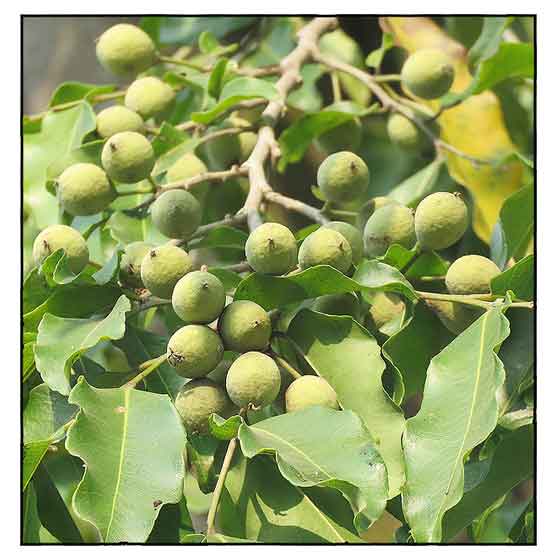 Gen info Gen info
- Putranjiva is a plant genus in the family Putranjivaceae, first described as a genus in 1826.
-
Etymology: The specific epithet roxburghii honors Wallich Roxburgh (1751-1815), director of the Calcutta Botanical Garden (1793-1814), writer of "Flora Indica", which was published after his death. (4)
- In India, the plant has been a subject of Parliamentary political discord
among opposition leaders when an Ayurvedic drug named Putrajeevak Beej was being marketed promising a male child: the name literally meaning "the seed that gives life to a son"-- an issue magnified by India's declining sex ratio and gender imbalance. The manufacturer later clarified that the drug was meant for the treatment of infertility, with nothing to do with sex selection. (3)
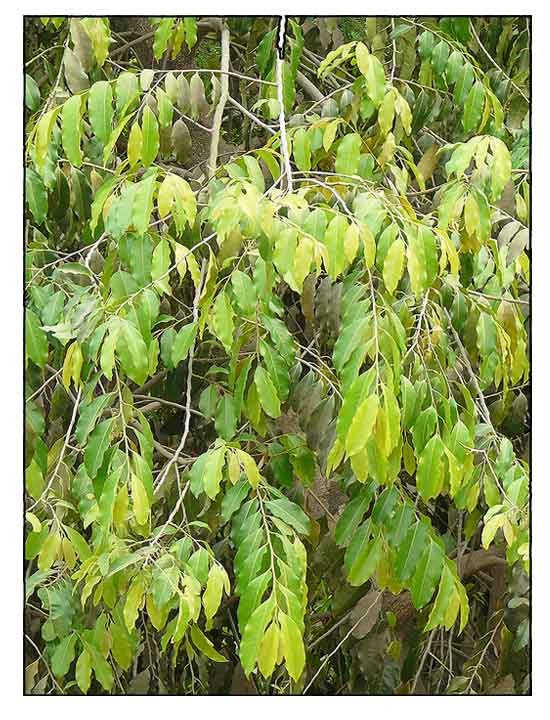 Botany Botany
• Tree, up to 15 m high, with drooping leaves, dioecious; bark thin, grey; young shoots pubescent, branches glabrescent. Leaves distichous; petiole 0.5–1 cm long, pubescent; blade oblong, oblong-elliptic or elliptic, 4–14 by 2–5 cm, subcoriaceous, glabrous, base obliquely cuneate, margin crenate or serrate, slightly undulate, apex acuminate, acute or obtuse, dark green above, light green beneath; nerves very thin, irregularly arranged, veins and veinlets reticulate. Flowers yellowish green. Staminate flowers axillary in dense clusters or clustered on a 1–3 cm long peduncle, 1–2 mm in diam.; pedicel short; sepals 4 or 5, unequal, margin ciliate; stamens 3 or 4, filaments 0–2 mm long; anther semiglobose, sparsely hairy or glabrous; disc absent. Pistillate flowers 1–4 together; pedicel short; sepals 5, lobes erect, very unequal; ovary densely hairy, contracted into the style, 2- or 3-locular; stigmas 2 or 3, recurved, subsagittate, caducous. Fruits on a 4–16 mm long pedicel, ovoid to globose, 1.5–2.7 by 0.6–2 cm, white tomentose. Seed 1. (eFlora of Thailand)
Distribution
- Native to the Philippines. (2)
- Found in Polillo, Samar.
-
Also native to Assam, Bangladesh, Borneo, Cambodia, East Himalaya, India, Jawa, Laos, Lesser Sunda Is., Malaya, Maluku, Myanmar, Nepal, New Guinea, Pakistan, Sri Lanka, Sulawesi, Thailand, Vietnam, West Himalaya. (1)
- Ornamental cultivation.
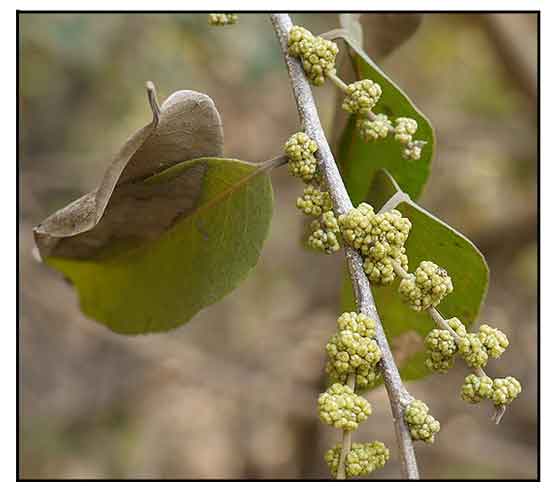 Constituents Constituents
- Ethanolic extract of leaves have yielded phenolic compounds such as gallic acid, ellagic acid; aqueous extracts of leaves have yielded caffeic acid, ferulic acid, syringic acid, vanillic acid, genistic acid, and catechin. Fruits contain mannitol; the fruit peel, linalool, citronellal, citronellic acid, geraniol, geranyl acetate, ß-bisabolene, docosenamide, caryophyllene oxide, etc. (8)
- Phytochemical screening of methanol extract of seeds showed presence of phenols, alkaloids, saponins, steroids, flavonoids, and glycosides. (see study below) (9)
- Histochemical analysis revealed the presence of lignins, starch, alkaloids, tannins, and calcium oxalate crystals. Saponins are present in the leaf, root, and stem, absent in seeds. (14)
- GC-MS analysis of ethanolic extract of seeds yielded 20 phytoconstituents. Major constituents included n-propyl heptyl ether (25.25%), 5-ethyl hydantoin (8%), octadec-9-enoic acid (16.25%), and 1,2-benzene dicarboxylic acid (11.86%). (see study below) (16)
- Study of bark yielded a new triterpene, roxburghonol (6) along with five known triterpenoids, friedlein (1), methylputranjate (2), putrone (3),
roxburghonic acid (4), and putranjivadione (5). (see study below) (17)
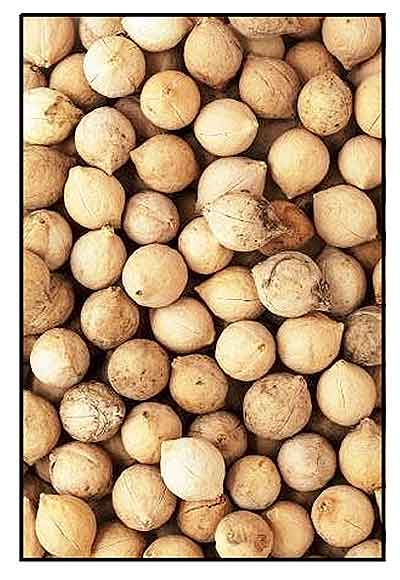 - Study of ethanol extract of fresh leaves yielded triterpenoids, ellagic acid, gallic acid, gallocathechin, ellagi- and gallo-tannins and saponins. Root bark yielded triterpenoids, friedlin, putranjivadione, roxburgholone, methyl putrate, and saponins. (19) - Study of ethanol extract of fresh leaves yielded triterpenoids, ellagic acid, gallic acid, gallocathechin, ellagi- and gallo-tannins and saponins. Root bark yielded triterpenoids, friedlin, putranjivadione, roxburgholone, methyl putrate, and saponins. (19)
- Study of ethanol and methanol crude extracts from leaf and stem yielded abundant amounts of alkaloids, coumarins, tannins, phenol, glycosides, and reducing sugar, with absence of saponin and steroids. (23)
- GC-MS analysis of ethanol extract of fruit peel
yielded major compounds of cyclohexanol, 5-methyl-2-(1-methylethenyl)- (4.56%), 6-octen-1-ol, 3,7-dimethyl- (41.07%), geraniol (2.45%), )1R,2S,5R)-2-(2-hydroxy-2-propanyl)-5-methylcyclohexanol (14.09%), 2,6-octadiene, 2,6-dimethyl- (7.04%), p-menthane-3,8-diol, cis-1,3,trans-1,4- (3.39%), 2,6-octadien-1-ol, 3,7-dimethyl-, acetate (6.69%) and 13-Docosenamide, (Z)- (2.83%). (24)
- HPTLC study of bark for bioactive triterpenoids yielded friedelin (1), methylputranjate (2), putrone (3), roxburghonic acid (4), putranjivadione (5), and roxburghonol (6). (28)
- Study evaluated seeds for oil content and fatty acid
composition during different stages of maturity. Fatty acid composition consisted of lauric, myristic, palmitic, palmitoleic, stearic, oleic, linoleic, and arachidic acids. Oleic and linoleic acids were found abundant. (see study below) (34)
- Methanolic extracts of seeds and pericarp yielded alkaloids, carbohydrates, glycosides, flavonoids, phenols, tannins, fixed oils, coumarins, saponins, sterols, and terpenoids.
(see study below) (36)
Properties
- Leaves considered procreant, bitter, refrigerant, and astringent. (14)
-
Studies have suggest cytotoxicity, pro-fertility, antinociceptive, antipyretic, anti-inflammatory, antibacterial, preservative, antioxidant, α-amylase and α-glucosidade inhibitory, antimalarial, anticancer, laxative, hypoglycemic, hypocholesterolemic, antifungal properties.
Parts used
Leaves, fruits, seeds.
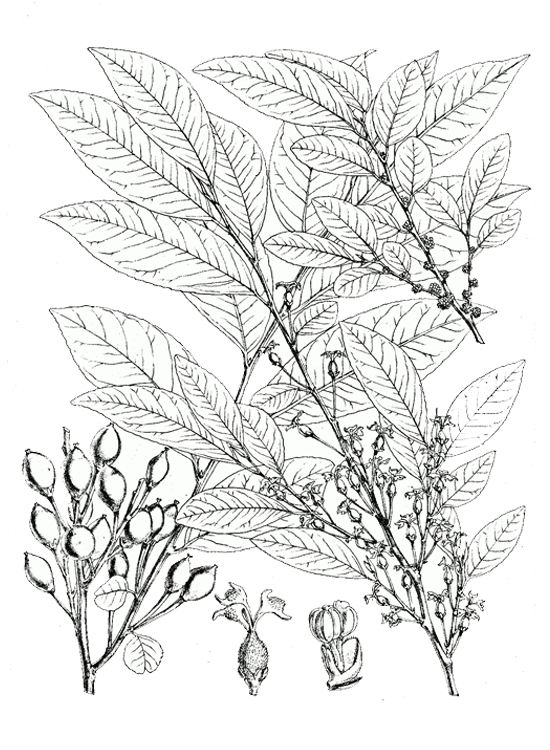 Uses Uses
Edibility
- Drypetes species are known to provide edible fruits.
- Dried fruits and decoction of seeds used for treatment of colds and fever.
Folkloric
- Use for treating infertility in women; hence, the name 'childlife tree'.
- Leaves and fruit used for treatment of fever, muscle twitching, rheumatism, arthralgias, constipation, catarrh, azoospermia.
- In various traditional medicinal systems, used for treatment of fever, cold, cough, headache, inflammations. Leaf decoctions used for liver disorders, rheumatic joints, eye and throat infections. Pastes applied to insect bites, filariasis, allergic patches, and burning sensations. Fruits consumed for laxative and diuretic effect. A constituent in herbal formulations to treat azoospermia and to increase sperm count. (8)
- In Thai medicine, leaves and fruits used for treatment of muscle sprains and arthralgias; whole plant used for hemorrhoids. (14)
- Women munch on the nuts to influence the birth of a male child.
- Used for the treatment of mouth and stomach ulcers, hot swellings, burning sensations, small pox, and eye inflammation. (17)
- In Ayurveda and Sidha, plant useful for women whose child died in-utero.
Others
- Superstitions / Cultural beliefs: Fruits are used as charms to keep children in good health. Believed to increase fertility and conception in women. (•) Fruits and seeds worn as necklaces by expectant mothers to assure easy delivery. (8) Fruits strung as necklace to form rosaries and used as necklace to protect children from harm. Fruit necklaces worn by pregnant women to prevent miscarriages. Garland of dried fruits worn as necklace to cure and treat skin allergy and itches. (33)
- Politics: An issue arose in the Indian Parliament for a claim that the Ayurvedic medicine being marketed promising a male child. Later, the manufacturer clarified that the drug is meant for the treatment of infertility rather than sex selection. (3)
- Seeds: Yield an fatty oil used for burning.
- Leaves: Used as fodder.
Studies
• Effect of Seed Extracts on the Gonads of Mice: Study evaluated the effects of methanol extracts of Putranjiva roxburghii and Diplocyclos palmatus seeds at doses of 100 mg/kbw on reproductive physiology of albino mice. Characterization of the seed extracts showed presence of tannic acid, rutin, and quercetin, besides other phytocompounds. There was a significant rise in sperm count in the males and maintained estrus phase of estrous cycle in the females in the treated groups. Results suggest the ME may lead to an increase in steroid hormones testosterone and estradiol in male and females, thus enhancing the reproductive stability of the animals. (5)
• Antinociceptive / Antipyretic / Anti-Inflammatory / Leaves: Study evaluated the effects of ether extract of leaves on nociceptive responses in mice using writhing, hot plate, and formalin tests, and antipyretic activity using yeast-induced fever in rats, and anti-inflammatory activity using carrageenan-induced paw edema in rats and croton-oil induced ear and anus edemas, with extract doses of 100, 200, and 400 mg/kg p.o. Results showed dose-dependent analgesic activity in acetic acid-induced writhing with no significant effect in hot plate test. At 400 mg/kg, there was significant suppression of licking activity in the late phase of formalin test in mice and reduced fever induced by yeast in rats. There was moderate inhibition of inflammation in carrageenan-induced paw edema and dose-dependent inhibition of croton oil-induced ear edema. At 800 mg/kg, the extract decreased anus edema. Results showed analgesic, antipyretic and anti-inflammatory activities. (7)
• Cytotoxicity / Brine Shrimp Lethality Assay / Seeds: Phytochemical screening of methanol extract of seeds showed presence of phenols, alkaloids, saponins, steroids, flavonoids, and glycosides. The extract showed cytotoxicity with LC50 of 427.74 µg/mL in brine shrimp lethality assay. (9)
• Oil as Preservative for Peanuts During Storage: Fifteen species of fungi and one insect, Trogoderma granarium was isolated from peanut seed samples from stores in Uttar Pradesh, India. Volatile oils were extracted from 32 plant species and evaluated against the dominant fungi, Aspergillus flavus and A. niger, and T. granarium. The oil of Putranjiva roxburghii exhibited greatest toxicity, which was fungicidal and thermostable at its minimum inhibitory concentration (MIC) of 400 ppm. The oil protected the peanut seeds completely for 6 months, without exhibiting adverse effect on seed germination, seedling growth and general health and morphology of plants. Results suggest the oil of Putranjiva roxburghii has potential as peanut seed preservative against spoilage against fungi and insects during storage. (10)
• Antibacterial / Seeds: Study evaluated the antibacterial activity of dried seeds of P. roxburghii. The ethanol extract of seed showed highest zone of inhibition in all bacterial strains tested viz. gram-positive Staphylococcus aureus (16 mm), Streptococcus mutans (19mm), Bacillus subtilis (20mm), and gram-negative Escherichia coli (21mm), Klebsiella pneumonia (14mm), Proteus vulgaris (16mm). (11)
• Quebrachitol / Antimalarial / Twigs: Study evaluated the in-vitro and in-vivo anti-malarial efficacy of Putranjiva roxburghii twigs ethanol extract and fraction (PRT) using a chloroquine-sensitive Plasmodium falciparum strain. Crude ethanol extract of the PRT showed most moderate antiparasitic activity with IC50 of 15.51 µg/mL. A butanol fraction showed potent activity with IC50 of 5.14 µg/mL with selectivity index (SI) of 28.87. Two phytochemicals were identified viz. 2,4-dihydroxy-5-(hydroxymethyl) benzoic acid (DHMBA) and quebrachitol (QBC). QBC significantly inhibited in-vitro growth of P. flaciparum with IC50 of 0.87 µg/mL. In-vivo studies confirmed the significant antimalarial activity of QBC at dose of 30 and 60 mg/kbw with chemosuppression values of 73.26% and 61.88%, respectively, in Plasmodium berghei infected mice with improved survival time. Results suggest the antiplasmodial potential of PRT, and the role of QBC in suppressing parasitemia. QBC has potential as lead for a natural product-based adjunct remedy for malarial infections. (12)
• Antimicrobial / Antioxidant / Leaves: Study evaluated acetone, chloroform, aqueous, and ethanol leaf extracts of P. roxburghii for antimicrobial and antioxidant activities. Study confirmed antimicrobial and antioxidant properties attributed to flavonoids, saponins, and phytosterols. (13)
• Pharmacological Attributes / Stem, Leaf, Fruit: Study evaluated the phytochemicals and therapeutic activities of crude extracts of P. roxburghii. Maximum phenolic content was found in distilled water extracts of stems and leaf, while highest flavonoid content was found in the ethyl acetate leaf extract. HPLC-DAD analysis showed various polyphenols in ranges of 0.02 to 2.05 µg/mg. Maximum DPPH activity was exhibited by MeOH stem. Maximum DPPH scavenging activity was shown by ME of stem. Highest antioxidant and reducing power was showed by ME of stem and leaf. Proficient antibacterial activity was shown by aqueous extract of leaf against Bacillus subtilis and Escherichia coli. Ethyl acetate fruit extract and n-hexane leaf extract showed remarkable α-amylase and α-glucosidase inhibition potential. In brine shrimp lethality assay, 41.67% of extracts were extremely cytotoxic with LC50s < 50µg/mL. The extracts showed antifungal and protein kinase inhibition activities. (15)
• Anti-epileptic / Seeds: Study evaluated the ethanolic extract of P. roxburghii seeds for antiepileptic potential using pentylenetetrazol (PTZ) kindling model of epilepsy and maximal electroshock epilepsy (MES) model. GC-MS analysis yielded 20 phytoconstituents. The extract at 50 mg and 100 mg/kg afforded dose-dependent protection against PTZ- and MES-induced epilepsy (p<0.001 and p<0.01). Results showed antiepileptic potential. (see constituents above) (16)
• Anti-Plasmodial / Bark: Study of bark yielded a new triterpene, roxburghonol (6) along with five known triterpenoids. Anti-plasmodial activity was investigated by measuring parasite-specific lactate dehydrogenase (pLDH) based in vitro assay. IC%)s of friedlein (2.40) (1) and roxburghonol (6) (4.10 µg/mL) showed better anti-plasmodial activity than other isolated triterpenes, but not as potent as chloroquine (0.023 µg/mL) against chloroquine-sensitive Plasmodium flaciparum (3D7) strain. (see constituents above) (17)
• Antibacterial / Antioxidant / Fruit Peel: Study evaluated the invitro antioxidant and antibacterial activity of 95% ethanolic extract of P. roxburghii fruit peel. Extract showed excellent antioxidant activity with IC50 of 17.3 µg/mL by DPPH assay. In antibacterial testing, the extract inhibited growth of both Bacillus subtilis and E. xianfangensis with dose-dependent inhibition zones. (18)
• Hypoglycemic / Leaves: Study evaluated the hypoglycemic activity of ethanolic extract of leaves of Putranjiva roxburghii in alloxan-induced diabetic in male albino rats. Using doses of 250 and 500 mg/kg, results showed significant dose-dependent hyperglycemic effect. The effect was less effective than reference standard, Glibenclamide. Flavonoids and tannins in the extract may be responsible for the antidiabetic effect. (20)
• Cytogenetic Toxicity / Leaves: Study evaluated the cytogenetic toxicity of leaf extract of Putranjiva roxburghii administered orally to young weaning Swiss albino mice at 0.5, 1.0 or 2.0 g/kbw/ daily for seven consecutive days. Results showed the leaf extract significantly induced mitosis-disruptive chromosomal changes in bone marrow cells. No change in incidence of structural abnormalities was noticed among metaphase chromosomes. Study proposed the extract might have interfered with the spindle and other proteins causing polyploidy, aneuploidy, c-mitosis, etc. (21)
• Silver Nanoparticles / Antibacterial / Anticancer against MCF-7 Line: Study reports on the easy, inexpensive, eco-friendly, green synthesis of silver nanoparticles using aqueous extract of P. roxburghii seed. The AgNPs showed considerable antibacterial effects against S. aureus, S. pneumoniae, and E. faecalis. Cytotoxic effect tested on human breast cancer cells line showed decrease in % viability of human breast cancer cell line cells at 12.5 to 200 µg/µl concentration with IC50 of 72.32 µg/ml. Results suggest potential use against human breast cancer. (22)
• Acute and Subacute Toxicity Studies / Potential for Reproductive Disorders / Leaves: Study evaluated the acute and subacute toxicity of P. roxburghii hydroalcoholic extract of leaves in a rat model. Acute toxicity study in healthy rats with dose of 2000 mg/kbw leaf extract showed no clinical signs of toxicity--setting an LD50 above 2000 mg/kg. Subacute toxicity study used doses of 100, 200, and 400 mg/kbw. Results showed no difference between untreated and test rats. In vitro study showed the leaf extract exerted pro-apoptotic effect on endometrial primary cells. Results suggest the leaf extracts are potentially safe and may have use for cure of reproductive disorders. (25)
• Laxative / Leaves: Study evaluated the possible laxative effect of P. roxburghii hydroalcoholic extract of leaves in albino Wistar rats. Extract doses of 250, 500, and 750 mg/kg were used. Results showed significant laxative activity and reduced loperamide induced constipation in a dose dependent manner. The 500 mg/kg dose p.o. effect was similar to reference drug sodium picosulfate at 5 mg/kg p.o. (26)
• Hypoglycemic / Antioxidant / Anti-Cholesterolemic / ß-Cell Protective / Bark: Study evaluated the antidiabetic activity of ethyl acetate extract of P. roxburghii bark in STZ-induced diabetic rats using doses of 250 and 500 mg/kg by oral route for 21 days. At 500 mg/kg, there was significant rise in body weight, decrease in blood sugar and total cholesterol, and restoration of SOD and CAT enzyme function (p<0.05). Pancreatic necrosis was less observable in the treated group. Results showed antihyperglycemic, anticholesterolemic, antioxidant, and improved cell density of ß-cells of islets of Langerhans in diabetic rats. (27)
• Zinc Oxide Nanoparticles / Cytotoxicity towards Cancer Cell Lines / Leaves: Study reports on the biosynthesis of zinc oxide nanoparticles (ZnONPs) using aqueous leaf extract of P. roxburghii. Two particles, PJ14 and PJ18, were identified. The NPs were evaluated for cytotoxicity against CaCo2 (human colorectal adenocarcinoma), colon cancer cell line, and HEK 293 (Human embryonic kidney), a normal cell line. The IC50s of PJ14 and PJ18 in CaCO2 were 44.79 µg/ml and 70.81 µg/mL, respectively. Results showed potential cytotoxic properties of the synthesized particle and selective toxicity of ZnONPs towards cancer cell lines as compared to normal cell lines. (29)
• Antiparasitic against Leishmania donovani / Leaves: Study evaluated the efficacy of P. roxburghii (PR) against sensitive and resistant promastigotes of L. donovani. GC-MS profiling revealed the extract was rich in myo-inositol-4-C-methyl, azulene, and desulphosinigrin. PR was rich in phenols, flavonoids, and terpenoids. Results showed IC50s of 25.6t1 and 29.02 µg/mL of PR against sodium stibogluconate sensitive and resistant strain, respectively. It was found safer in cytotoxicity assay and generated ROS mediated oxidative stress in parasitic cells evidenced by increased and decreased levels of superoxide radicals, lipid peroxidation products, lipid bodies, and levels of thiol, plasma membrane integrity. Results suggest potential for exploration as an antileishmanial agent. (30)
• Silver Nanoparticles / Anticancer (Colon, Pancreatic, Breast) / Seed: Study reports on the synthesis of silver nanoparticles using P. roxburghii seed extract and improving bioavailability to enhance anticancer activity against HCT-116 (colon carcinoma), PANC-1 (pancreatic carcinoma), MDA-MB 231 (breast carcinoma) cell lines. Cytotoxicity pattern was AgNO3>PJSNPs>PJ extract. Process of cell death was via apoptosis mechanism and PJSNPs were exerting late-stage apoptosis in all tested cell lines. Results suggest potential for biologically synthesized PJSNPs as target in field of anti-cancer drug discovery. (31)
• Uterine Tonic / Herbal Medicated Feed: Study evaluated the efficacy of an herbal medicated feed containing Putranjiva roxburghii on female wistar rats. Results showed the formulation to be an effective uterine tonic. The herbal feed improved progesterone level in the treatment group. Conception rate and survival rate in all experimental animals were 100%. Number of pups born in the treatment group was increased. (32)
• Oil Content and Fatty Acid Composition / Seeds: Study evaluated seeds for oil content and fatty acid
composition during different stages of maturity. Fatty acid composition consisted of lauric, myristic, palmitic, palmitoleic, stearic, oleic, linoleic, and arachidic acids. Oleic and linoleic acids were found abundant. Significant changes in the contents of saturated fatty acids (palmitic and stearic) and unsaturated fatty acids (oleic and linoleic) were observed during seed development. Oleic acid in fully matured seeds was the major component (57.6%) followed by linoleic acid (29.9%), palmitic (6.2%), and stearic (5.1%) -- the four constituted about 98.8% of total fatty acids. (34)
• Antifungal / Seeds and Pericarp: Study evaluated the seeds and pericarp of P. roxburghii for antifungal activity against C. albicans, C. tropicum, R. stolonifer, M. canis and T. rubrum. Methanolic extracts yielded alkaloids, carbohydrates, glycosides, flavonoids, phenols, tannins, fixed oils, coumarins, saponins, sterols, and terpenoids. For both samples antifungal activity showed higher value against Trichophyton rubrum. (36)
Availability
Wild-crafted.
Seeds in the cybermarket.
|

![]()





 Constituents
Constituents

